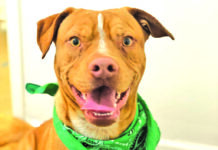One of the greatest dilemmas we have for our dogs and ourselves is when it comes time to find professional help for our 4-legged companions.
Because there is no national standard – like the bar for lawyers or boards for doctors – it’s an educated guess as to whom we should trust our pets with, especially when dire help is needed.
Let me try to help with the philosophy part of things.
I always ask my clients a simple question. Would you prefer your dog to want to make the decision, or would you rather choose to make the decision for him?
Unequivocally, every single one of them prefers the former. If you are like them, then let me introduce you to the principles of modern dog training, or positive-based reinforcement without the use of force.
The term “positive reinforcement” was coined by the brilliant scientist and psychologist, B.F. Skinner.
According to Skinner, “(Positive reinforcement) occurs when a behavior is followed by a stimulus that is appetitive (appealing) or rewarding, increasing the frequency of that behavior;” punishment is specifically excluded.
There truly is a science behind it, and once the principles are understood, everything will fall into place, accordingly.
The “F” word plays a major role in positive-based reinforcement. It’s another four-letter word, and to some, it might as well be one of the forbidden.
Of course, I’m talking about food, and it’s what we call an unconditioned reinforcer. Like air, water, and shelter, dogs do not need to think about whether food is rewarding.
Motivation is a huge reason dogs make the decisions they make, and there isn’t a better (and more humane) motivator than food. Food allows us to lure a dog into a behavior.
Food allows us to reward a dog for making the correct decision. Food allows us to help a shy dog feel more confident.
So, why do even some “positive-based” trainers swear off the use of tasty morsels? I’m not exactly sure, but it probably has something to do with the idea of “bribing” the dog, or becoming a “slave” to treats.
Let me be clear: food should not be used as bribery (like waving a piece of food to get a dog to come to you), and if it is, it’s being used incorrectly. Also, once the dog “gets it,” then food can be faded away.
But, I will gladly wear the red “F” on my chest because it works – time and time again – for basic obedience, for advanced obedience, and yes, for even aggression cases, especially those based in fear (which is the majority of all aggression).
Positive reinforcement is not without consequences, though. Those consequences just don’t involve leash corrections, force, or scare tactics.
While dogs learn what to do through rewards for making the correct decisions, they learn what not to do by the elimination of that reward when they make a mistake.
When they understand alternate behaviors are more rewarding, they soon learn what not to do. For example, when dogs know to sit when greeting a guest, they learn two things: one, it is more rewarding to sit because they get pet and possibly rewarded with a delicious something, and they learn that jumping is not acceptable, because nothing’s in it for them—especially attention.
Now, isn’t that more fun and eases your mind more than having to knee the dog to stop jumping, or yanking on a leash?
Let’s all get more positiveYour dog will relish it, and your bond will never be stronger.













